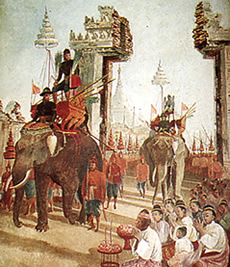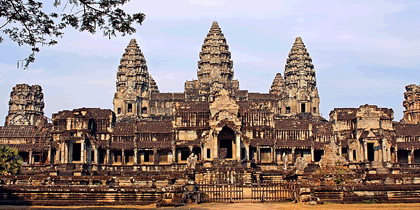World History
The emergence of Thai kingdoms in the 13th century changed the power configuration of mainland Southeast Asia. Angkor and Pagan both felt their military might. The conquest of Nan Chao by the Mongols accelerated the process of Thai migration. The kingdoms emerged from alliances between the leaders of muangs (unit of cluster of villages).
Prince Mengrai (1239–1317) had established the kingdom of Lanna. In 1281 he conquered the kingdom of Haripunjaya and crushed the Mon-Khmer outpost of the area. The founder of Sukhothai, Sri Indraditya (r. 1238–70), overthrew the Khmer overlordship in Thailand.
Rama Khamheng (1239–98), the third ruler, carved out a vast empire ruling over ethnic groups like the Burmese, Mon, Lao, and Khmers. After the emergence of Ayutthaya, the tables were turned and the Siamese attacked the Khmers.
In 1350, Rama Tibodi I (1312–69) founded the kingdom of Ayutthaya, which dominated Siamese history for four centuries. A new capital city was established and Tibodi named the capital after Rama, the hero of the Ramayana, an important Indian epic.
The strategic location of the capital city facilitated attacking the Khmers. Tibodi was bent upon claiming overlordship of the region. The first Siamese invasion began in the year 1352 under the command of Prince Ramesuan (r. 1369–70 and 1388–95).
The Khmer ruler Jayavarman Paramesvar (r. 1327–52) became a vassal of Ayutthaya. However, control of Ayutthaya did not last long and the Khmer ruler Kambujadhiraj (r. 1377–83) recovered Angkor.
Among the rulers of Ayutthaya, two different policies alternated. The Lopburi faction wanted to establish Siamese hegemony over the Khmers. But the Suphanburi faction was interested in subduing the Thai kingdoms and visualized Sukhothai, rather than Angkor, as a rival.
Borommaracha I (r. 1370–88), who was from Suphoburi, did not follow an active policy toward the Khmers and concentrated his energy in subduing Sukhothai. Tibodi and his son Ramesuan along with grandson Ramatacha (1395–1404) were from Lopburi and perceived the threat from Angkor as greater than that of Sukhothai.
Ramesuan attacked the Khmers for the second time in 1389. The immediate result of the invasion was the capture of Chonburi and Chantaburi by the Khmer ruler Dharmasokaraj (r. 1383–89), who also captured the majority of the population.
The troops of Ayutthaya seized Angkor for seven months and took 90,000 Cambodians as prisoners. In 1431 the Ayutthaya King Borommaracha II (r. 1424–48) invaded Angkor again, killing the ruler Srey (sometimes called Tammasok). Prince Intaburi, son of Borommaracha I, was installed as the new king.
But Intaburi’s reign was short-lived and after his death, Angkor again became independent. The Khmers shifted their capital to Phnom Penh in 1432 and their domain was confined to a small area. The objective of making Angkor a vassal state was not realized.
Trailok (r. 1448–88), the eldest son of King Boromaraja II, was one of the greatest Thai monarchs and reformers. He did not pay attention to Angkor and was involved in continuous war with Chieng Mai.
The Siamese attack against the Khmers did not result in Angkor’s becoming a part of Audhya for a long time. After the attack was over and Thai forces retreated back to Ayutthaya, the Khmers reasserted their independence.
The sacking of their capital incurred heavy losses in terms of men and material. From the Siamese viewpoint, they had gained the upper hand and Ayutthaya was safe from attack by the Khmers.
The domination of Cambodia over Thailand was a thing of the past. A general pattern was also emerging in the internecine wars of the Burmese, Khmers, and Thais. Apart from ransacking the towns and imposing tributes, the victorious power was taking much of the population to make up for those killed in the wars.
The result was an ethnic mix in mainland Southeast Asia. The Angkorean features in both the social and cultural domain percolated to Siamese society. The Thais were influenced by the Khmer concept of monarchy, and the system of slavery.
- Dvaravati
Dvaravati map The Mon kingdom of Dvaravati (also called Siam) flourished in what is now Thailand from the sixth century c.e. to around the 11th century. The kingdom covered the political area of Nakhon Pathom (west of present-day Bangkok), U-Thong, and...
- Khmer Kingdom
Map of Khmer Kingdom Until 802 the Khmers were organized into a number of warring independent kingdoms. They often fought among themselves and against foreign enemies such as the Chams located in present-day central Vietnam. King Jayavarman I, also named...
- History Of Thailand
History of Thailand. This is a good short essay on the history of the Asian nation of Thailand. Wikipedia notes, "The Kingdom of Thailand is a country in Southeast Asia, bordering Laos and Cambodia to the east, the Gulf of Thailand and Malaysia to the...
- History Of Cambodia
History of Cambodia. This is a good overview to the history of the Asian nation of Cambodia. From the site: Over a period of 300 years, between 900 and 1200 AD, the Khmer Kingdom of Angkor produced some of the world's most magnificent architectural...
- History Of Burma
History of Burma. This is a good general overview to the history of the Asian nation of Burma. I realize that the legal name of the country is now Myanmar but who the heck calls it that? From the site: Burma was unified by Burman dynasties three...
World History
Siamese Invasion of the Khmer Kingdom
 |
| Siamese army |
Prince Mengrai (1239–1317) had established the kingdom of Lanna. In 1281 he conquered the kingdom of Haripunjaya and crushed the Mon-Khmer outpost of the area. The founder of Sukhothai, Sri Indraditya (r. 1238–70), overthrew the Khmer overlordship in Thailand.
Rama Khamheng (1239–98), the third ruler, carved out a vast empire ruling over ethnic groups like the Burmese, Mon, Lao, and Khmers. After the emergence of Ayutthaya, the tables were turned and the Siamese attacked the Khmers.
In 1350, Rama Tibodi I (1312–69) founded the kingdom of Ayutthaya, which dominated Siamese history for four centuries. A new capital city was established and Tibodi named the capital after Rama, the hero of the Ramayana, an important Indian epic.
  |   |
The strategic location of the capital city facilitated attacking the Khmers. Tibodi was bent upon claiming overlordship of the region. The first Siamese invasion began in the year 1352 under the command of Prince Ramesuan (r. 1369–70 and 1388–95).
The Khmer ruler Jayavarman Paramesvar (r. 1327–52) became a vassal of Ayutthaya. However, control of Ayutthaya did not last long and the Khmer ruler Kambujadhiraj (r. 1377–83) recovered Angkor.
Among the rulers of Ayutthaya, two different policies alternated. The Lopburi faction wanted to establish Siamese hegemony over the Khmers. But the Suphanburi faction was interested in subduing the Thai kingdoms and visualized Sukhothai, rather than Angkor, as a rival.
Borommaracha I (r. 1370–88), who was from Suphoburi, did not follow an active policy toward the Khmers and concentrated his energy in subduing Sukhothai. Tibodi and his son Ramesuan along with grandson Ramatacha (1395–1404) were from Lopburi and perceived the threat from Angkor as greater than that of Sukhothai.
Ramesuan attacked the Khmers for the second time in 1389. The immediate result of the invasion was the capture of Chonburi and Chantaburi by the Khmer ruler Dharmasokaraj (r. 1383–89), who also captured the majority of the population.
 |
| Angkor |
The troops of Ayutthaya seized Angkor for seven months and took 90,000 Cambodians as prisoners. In 1431 the Ayutthaya King Borommaracha II (r. 1424–48) invaded Angkor again, killing the ruler Srey (sometimes called Tammasok). Prince Intaburi, son of Borommaracha I, was installed as the new king.
But Intaburi’s reign was short-lived and after his death, Angkor again became independent. The Khmers shifted their capital to Phnom Penh in 1432 and their domain was confined to a small area. The objective of making Angkor a vassal state was not realized.
Trailok (r. 1448–88), the eldest son of King Boromaraja II, was one of the greatest Thai monarchs and reformers. He did not pay attention to Angkor and was involved in continuous war with Chieng Mai.
The Siamese attack against the Khmers did not result in Angkor’s becoming a part of Audhya for a long time. After the attack was over and Thai forces retreated back to Ayutthaya, the Khmers reasserted their independence.
The sacking of their capital incurred heavy losses in terms of men and material. From the Siamese viewpoint, they had gained the upper hand and Ayutthaya was safe from attack by the Khmers.
The domination of Cambodia over Thailand was a thing of the past. A general pattern was also emerging in the internecine wars of the Burmese, Khmers, and Thais. Apart from ransacking the towns and imposing tributes, the victorious power was taking much of the population to make up for those killed in the wars.
The result was an ethnic mix in mainland Southeast Asia. The Angkorean features in both the social and cultural domain percolated to Siamese society. The Thais were influenced by the Khmer concept of monarchy, and the system of slavery.
- Dvaravati
Dvaravati map The Mon kingdom of Dvaravati (also called Siam) flourished in what is now Thailand from the sixth century c.e. to around the 11th century. The kingdom covered the political area of Nakhon Pathom (west of present-day Bangkok), U-Thong, and...
- Khmer Kingdom
Map of Khmer Kingdom Until 802 the Khmers were organized into a number of warring independent kingdoms. They often fought among themselves and against foreign enemies such as the Chams located in present-day central Vietnam. King Jayavarman I, also named...
- History Of Thailand
History of Thailand. This is a good short essay on the history of the Asian nation of Thailand. Wikipedia notes, "The Kingdom of Thailand is a country in Southeast Asia, bordering Laos and Cambodia to the east, the Gulf of Thailand and Malaysia to the...
- History Of Cambodia
History of Cambodia. This is a good overview to the history of the Asian nation of Cambodia. From the site: Over a period of 300 years, between 900 and 1200 AD, the Khmer Kingdom of Angkor produced some of the world's most magnificent architectural...
- History Of Burma
History of Burma. This is a good general overview to the history of the Asian nation of Burma. I realize that the legal name of the country is now Myanmar but who the heck calls it that? From the site: Burma was unified by Burman dynasties three...
